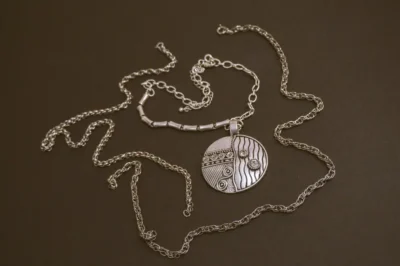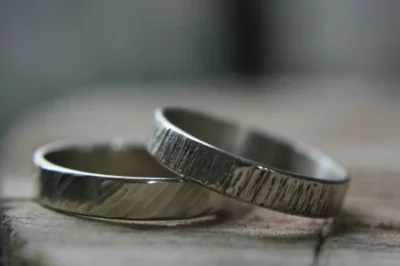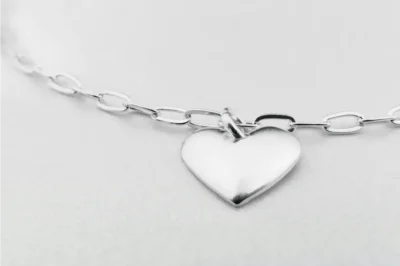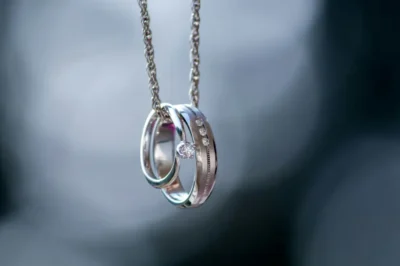Silver jewelry is loved all over the world for its timeless shine, elegant charm, and affordable luxury. From delicate sterling silver rings to bold statement necklaces, silver has earned a permanent place in every jewelry lover’s collection. But if you’ve owned silver for a while, you’ve probably noticed something: that beautiful, mirror-like shine doesn’t always stay perfect. Over time, your favorite bracelet might turn a little dull, or your silver ring may develop dark patches.
And so the big question arises: Why does silver jewelry tarnish—and what can you do to keep it looking as radiant as the day you bought it?
In this ultimate guide, we’re going to dive deep into everything you need to know about silver jewelry tarnish. We’ll uncover the science behind tarnishing, explain why some pieces tarnish faster than others, bust common myths, and most importantly—show you how to clean, prevent, and maintain silver jewelry for the long run.
What Is Silver Tarnish?
Before we talk about how to fix tarnish, let’s first understand what it actually is.
Tarnish is that dark, sometimes yellowish or black film that forms on silver over time. It’s not dirt. It’s not something that means your jewelry is fake. It’s actually a natural chemical reaction.
When silver comes into contact with sulfur-containing substances in the air (or sometimes even in your skin), it reacts and forms a thin layer of silver sulfide. This layer darkens the surface, giving silver a dull or blackened look.
Think of it like a patina—except unlike copper’s green patina, silver’s tarnish isn’t considered attractive. Most people want their silver jewelry to shine like a mirror, not look old and dull.
Why Does Silver Jewelry Tarnish?
Now that we know tarnish is a natural reaction, let’s break down the main reasons why silver jewelry tarnishes and why some pieces tarnish faster than others.
1. Moisture and Humidity
If you live in a humid climate, your silver jewelry is more likely to tarnish quickly. Moisture in the air accelerates the chemical reaction between silver and sulfur. That’s why silver stored in bathrooms (where it’s humid from showers) or worn in tropical regions tarnishes faster.
2. Contact with Skin Oils and Sweat
Everyone’s body chemistry is different. Some people can wear silver every day without much tarnishing, while others notice their jewelry darkening within weeks. The reason? Natural oils, sweat, and skin pH levels.
Sweat contains salt and other compounds that can react with silver. If you tend to perspire more or have more acidic skin, your jewelry may tarnish faster.
3. Cosmetics, Perfume, and Lotions
Beauty products are another big culprit. Perfumes, lotions, hairsprays, and even makeup contain chemicals that can trigger tarnish. For example:
- Perfumes often contain alcohol and oils.
- Lotions and creams can trap moisture against your jewelry.
- Hairspray often contains sulfur compounds.
The more your jewelry comes into contact with these substances, the faster it will tarnish.
4. Air Pollution and Sulfur Exposure
Air quality matters! If you live in a city with high pollution levels, your silver jewelry is exposed to more sulfur particles in the air. This speeds up tarnishing. Even seemingly innocent things—like cooking with eggs, onions, or garlic—release sulfur compounds into the air that can cause silver to tarnish when stored nearby.
5. Storage Conditions
Does silver jewelry tarnish faster if left out in the open? Absolutely. When silver is exposed to open air, it has a much higher chance of reacting with sulfur and oxygen. Leaving silver pieces in a jewelry dish or box without protection almost guarantees tarnishing over time.
Does All Silver Tarnish the Same Way?
Not all silver is created equal, and not all silver tarnishes at the same rate. Let’s look at the different types.
Sterling Silver vs Fine Silver
- Fine silver (99.9% pure) tarnishes the least because it contains very little copper or other alloys. However, it’s also soft and not always ideal for everyday jewelry.
- Sterling silver (92.5% silver + 7.5% other metals, usually copper) is stronger and more durable, which is why it’s the most common choice for jewelry. The downside? Copper tarnishes easily, so sterling silver tends to tarnish faster.
Silver-Plated vs Solid Silver
Silver-plated jewelry has just a thin layer of silver over a base metal like brass. While it still tarnishes, the thin layer may wear away over time, exposing the base metal. Solid silver, on the other hand, can always be polished and restored.
Rhodium-Plated Silver
Some jewelers add a rhodium plating to silver jewelry. Rhodium is resistant to tarnishing, so this protective coating helps keep silver bright longer. The only catch? Over time, the rhodium layer can wear off, especially on rings and bracelets.
Common Myths About Silver Tarnish
Let’s clear up some confusion. There are plenty of myths about silver tarnish that need debunking.
- Myth 1: Tarnish means your silver is fake.
False! Even the purest silver tarnishes. In fact, if your jewelry tarnishes, it’s a sign it actually contains real silver. - Myth 2: Only cheap silver tarnishes.
Wrong again. Even expensive sterling silver pieces from top designers will tarnish eventually. - Myth 3: Once silver tarnishes, it’s ruined.
Not true. Tarnish only affects the surface and can be easily cleaned off. Your jewelry underneath remains perfectly fine.
How to Prevent Silver Jewelry from Tarnishing
Now that we know tarnish is natural but not permanent, let’s talk about prevention.
Smart Wearing Habits
- Take off your silver jewelry before swimming, showering, or exercising.
- Avoid wearing silver when applying lotions, perfumes, or hairspray.
- Put jewelry on last when getting ready and take it off first when winding down.

Proper Storage Tips
- Store silver jewelry in airtight containers or anti-tarnish bags.
- Use anti-tarnish strips or silica gel packets to absorb moisture.
- Keep each piece separate to avoid scratching and tarnish transfer.
Professional Protective Measures
- Consider rhodium plating for frequently worn silver jewelry.
- Jewelers can also apply protective coatings that help slow down tarnishing.
How to Clean Tarnished Silver Jewelry Safely
Even with the best care, tarnish will eventually appear. Here’s how to clean it properly.
Gentle Home Methods
- Silver polishing cloths: These are specially designed to remove tarnish without scratching.
- Mild soap and warm water: Great for regular cleaning and removing light tarnish.
- DIY methods: Baking soda paste or aluminum foil with baking soda and hot water can help, but use with caution to avoid scratching.
Professional Cleaning
- Jewelers offer ultrasonic cleaning and professional polishing.
- Best option for heavily tarnished or intricate jewelry.
What NOT to Use on Silver
- Avoid toothpaste—it’s too abrasive.
- Don’t use bleach or ammonia—they damage silver.
- Stay away from harsh scrubbing tools.
Long-Term Maintenance: Keeping Silver Jewelry Shining
Maintaining silver jewelry is about consistency.
- Clean your pieces regularly with a polishing cloth.
- Store properly after each wear.
- Rotate jewelry so you’re not wearing the same piece every day.
- Take pieces for professional polishing every once in a while for a deep clean.
Silver vs Other Metals: Is Tarnish a Deal-Breaker?
Compared to other metals, silver does tarnish more easily. But that doesn’t make it less desirable.
-
- Gold: Doesn’t tarnish, but is much more expensive.
- Platinum: Extremely durable but pricey.
- Stainless steel: Tarnish-free, but lacks the prestige of silver.
Silver remains a favorite because it balances affordability, beauty, and versatility—and with proper care, it can last generations.
Conclusion
So, does silver jewelry tarnish? Yes, it absolutely does—but that’s not a flaw, it’s just part of silver’s natural character. Tarnishing doesn’t mean your jewelry is fake, cheap, or ruined. With the right cleaning methods, storage habits, and preventative care, your silver jewelry can stay radiant and elegant for years to come.
If you love silver’s timeless beauty, embrace it fully. Think of tarnish as a temporary visitor—one you have the power to chase away. With regular maintenance, your silver jewelry collection can shine just as brightly as the day you first wore it.






